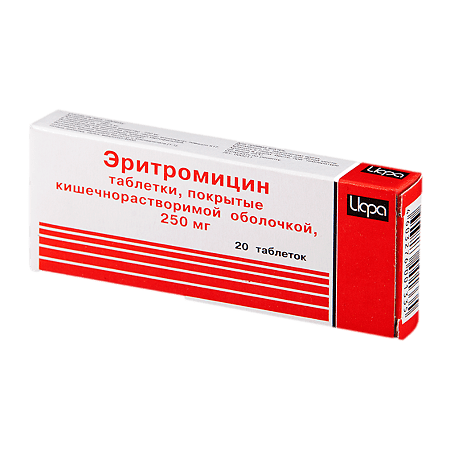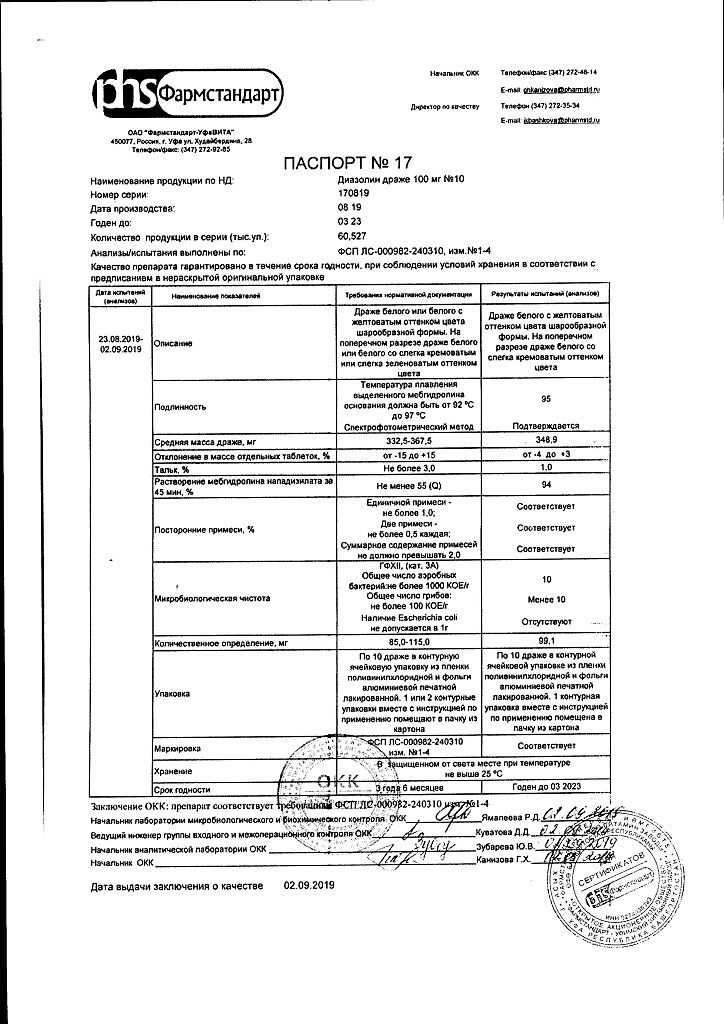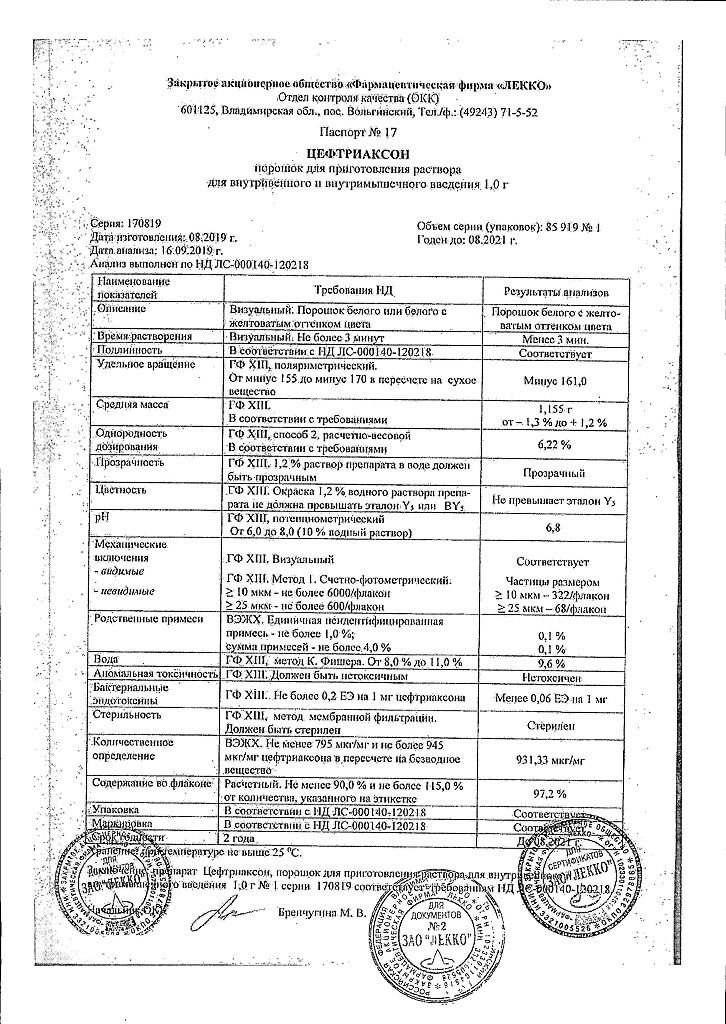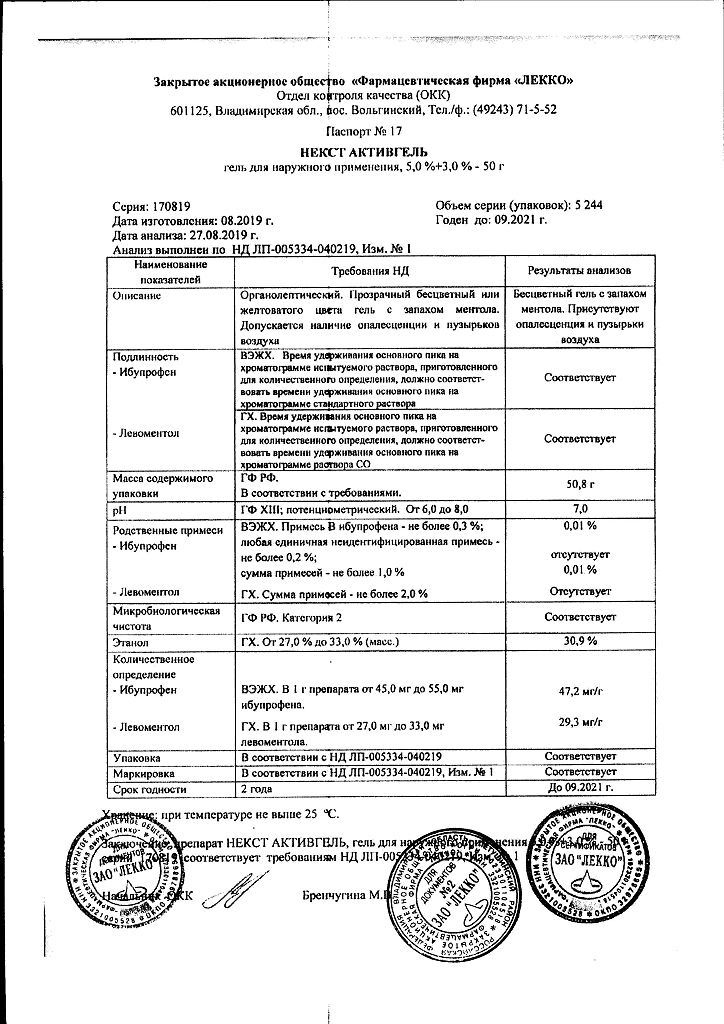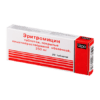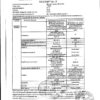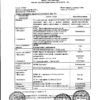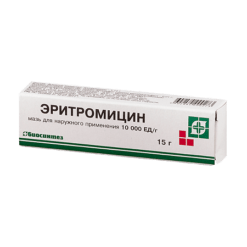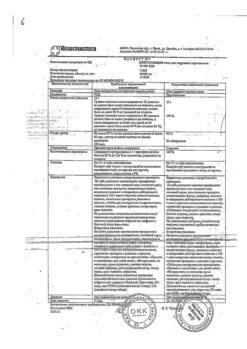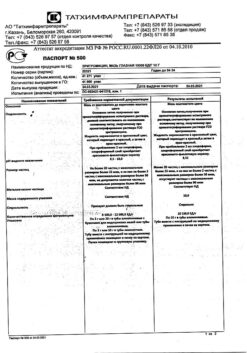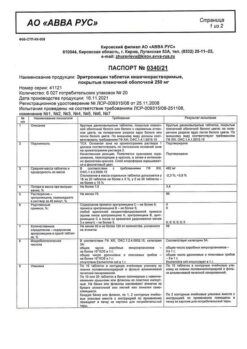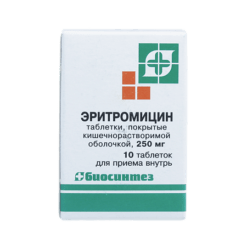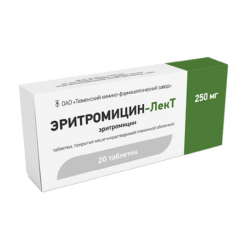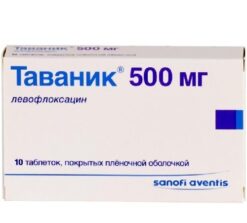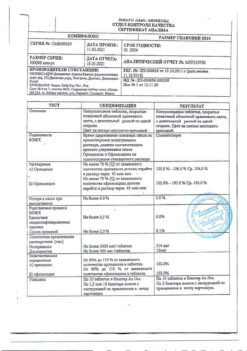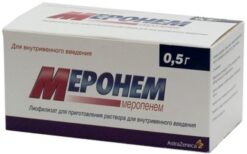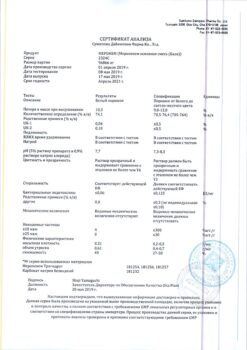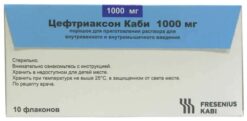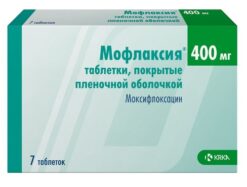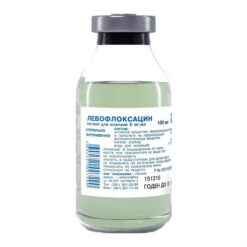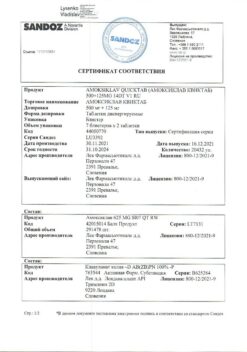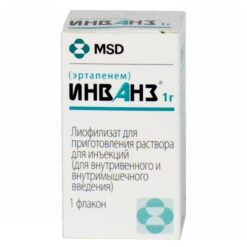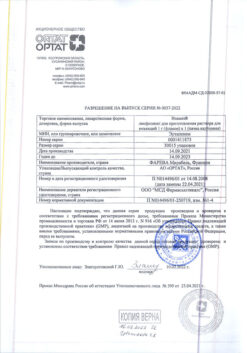No products in the cart.
Erythromycin, 250 mg 20 pcs
€6.32 €5.61
Description
Pharmacotherapeutic group
Macrolide antibiotic
ATX code: S01AA17
Pharmacodynamics:
Bacteriostatic antibiotic of the macrolide group. It binds irreversibly to 50S subunit of ribosomes which disrupts formation of peptide bonds between amino acid molecules and blocks protein synthesis in microorganisms (it does not affect synthesis of nucleic acids). When used in high doses depending on the type of pathogen it may show bactericidal effect.
Sensitive microorganisms are those which inhibit their growth at antibiotic concentration below 05 mg/l, moderately sensitive – 1-6 mg/l, resistant – more than 6 mg/l.
The broad spectrum of antimicrobial action of erythromycin includes:
Gram-positive microorganisms: Staphylococcus spp. producing and non-producing penicillinase including Staphylococcus aureus (except strains resistant to methicillin – MRSA); Streptococcus spp.Streptococcus pneumoniae Streptococcus pyogenes Streptococcus spp. viridans group); Bacillus anthracis Corynebacterium diphtheriae Corynebacterium minutissimum Listeria monocytogenes;
Gram-negative microorganisms: Bordetella pertussis Campylobacter jejuni Legionella spp. (including Legionella pneumophila) Moraxella (Branhamella) catarrhalis Neisseria gonorrhoeae; Haemophilus influenzae (some strains may be resistant to erythromycin but sensitive to other macrolide antibiotics);
other microorganisms: Chlamydia spp. (including Chlamydia trachomatis) Mycoplasma spp. (including Mycoplasma pneumoniae) Ureaplasma urealyticum Treponema spp. Propionibacterium acnes Entamoeba histolytica.
Eritromycin is resistant to Gram-negative bacilli: Escherichia coli and other members of the family Enterobacteriaceae (Klebsiella spp. Proteus spp. Salmonella spp. Shigella spp. and others); Pseudomonas aeruginosa; Acinetobacter spp. and other non-fermenting bacteria as well as anaerobic bacteria (Bacteroides spp. including Bacteroides fragilis) methicillin-resistant strains of Staphylococcus aureus (MRSA) and Enterococcus spp. mycobacteria.
It is a motilin receptor agonist. It accelerates the evacuation of gastric contents by increasing the amplitude of contraction of the pylorus and improving the antral-duodenal coordination has prokinetic properties.
Pharmacokinetics:
The absorption is high. Food intake has no effect on oral forms of erythromycin as base coated with a film-coated enteric-soluble coating.
Time to reach maximum concentration in blood plasma after oral administration – 2-4 hours Protein binding – 70-90%. Bioavailability is 30-65%. The drug is not evenly distributed in the body. Large amounts are accumulated in the liver, spleen and kidneys. The concentration in bile and urine is ten times higher than in plasma. It penetrates well into lung lymph node tissue, middle ear exudate, prostate secretion, sperm pleural cavity, ascitic and synovial fluid.
In milk of lactating women contains 50% of the concentration in plasma. It poorly penetrates through the blood-brain barrier (BBB) into the cerebrospinal fluid (CSF) (the concentration is 10% of the drug concentration in plasma). In inflammatory processes in the brain membranes their permeability to erythromycin increases slightly. It penetrates through the placental barrier and enters the fetal bloodstream where its content reaches 5-20% of the plasma content in the mother.
It is metabolized in the liver (more than 90%) partially with the formation of inactive metabolites. CYP3A4 CYP3A5 and CYP3A7 isoenzymes are involved in the metabolism of erythromycin. The elimination half-life (T1/2) is 14-2 h with anuria – 4-6 h. Excretion with bile – 20-30% unchanged by kidneys (unchanged) after oral administration – 2-5%.
Indications
Indications
Bacterial infections caused by susceptible pathogens:
– infections of the ENT organs (laryngitis, pharyngitis, tonsillitis, sinusitis, external and otitis media);
– lower respiratory tract infections (tracheitis, bronchitis, pneumonia);
– infections of the skin and soft tissues (pustular skin diseases, including juvenile acne, infected wounds, bedsores, stage II-III burns, trophic ulcers);
– biliary tract infections (cholecystitis);
– genitourinary infections in pregnant women caused by Chlamydia trachomatis;
– uncomplicated chlamydia in adults (with localization in the lower genitourinary tract and rectum) with intolerance or ineffectiveness of tetracyclines;
– primary syphilis (in patients with allergies to penicillins);
– gonorrhea;
– diphtheria (including bacterial carriage) whooping cough (including prevention) scarlet fever trachoma legionellosis (legionnaires’ disease) erythrasma listeriosis amoebic dysentery;
Prevention of exacerbations of streptococcal infections (tonsillitis, pharyngitis) in patients with rheumatism.
Prevention of infective endocarditis during dental interventions and operations on the ENT organs in patients with risk factors (heart defects, prosthetic valves, etc.).
Erythromycin is a reserve antibiotic for allergies to penicillin and other antibiotics of the penicillin group, as well as to other beta-lactams.
Pharmacological effect
Pharmacological effect
Pharmacotherapeutic group
macrolide antibiotic
ATX code: S01AA17
Pharmacodynamics:
Bacteriostatic antibiotic from the macrolide group. Reversibly binds to the 50S subunit of ribosomes, which disrupts the formation of peptide bonds between amino acid molecules and blocks the synthesis of microbial proteins (does not affect the synthesis of nucleic acids). When used in high doses, depending on the type of pathogen, it can exhibit a bactericidal effect.
Sensitive include microorganisms whose growth is delayed at an antibiotic concentration of less than 05 mg/l; moderately sensitive – 1-6 mg/l; resistant – more than 6 mg/l.
The wide spectrum of antimicrobial action of erythromycin includes:
gram-positive microorganisms: Staphylococcus spp. producing and non-producing penicillinase, incl. Staphylococcus aureus (except methicillin-resistant strains – MRSA); Streptococcus spp. (including Streptococcus pneumoniae Streptococcus pyogenes Streptococcus spp. viridans group); Bacillus anthracis Corynebacterium diphtheriae Corynebacterium minutissimum Listeria monocytogenes;
gram-negative microorganisms: Bordetella pertussis Campylobacter jejuni Legionella spp. (including Legionella pneumophila) Moraxella (Branhamella) catarrhalis Neisseria gonorrhoeae; Haemophilus influenzae (some strains may be resistant to erythromycin but sensitive to other macrolide antibiotics);
other microorganisms: Chlamydia spp. (including Chlamydia trachomatis) Mycoplasma spp. (including Mycoplasma pneumoniae) Ureaplasma urealyticum Treponema spp. Propionibacterium acnes Entamoeba histolytica.
Gram-negative bacilli are resistant to erythromycin: Escherichia coli and other representatives of the Enterobacteriaceae family (Klebsiella spp. Proteus spp. Salmonella spp. Shigella spp. and others); Pseudomonas aeruginosa; Acinetobacter spp. and other non-fermenting bacteria as well as anaerobic bacteria (Bacteroides spp. including Bacteroides fragilis), methicillin-resistant strains of Staphylococcus aureus (MRSA) and enterococci Enterococcus spp. mycobacteria.
It is a motilin receptor agonist. Accelerates the evacuation of gastric contents by increasing the amplitude of pyloric contraction and improving antral-duodenal coordination and has prokinetic properties.
Pharmacokinetics:
Absorption is high. Food intake has no effect on oral forms of erythromycin in the form of a base coated with a film enteric coating.
The time to reach the maximum concentration in the blood plasma after taking the tablets orally is 2-4 hours; the protein binding is 70-90%. Bioavailability – 30-65%. It is distributed unevenly in the body. It accumulates in large quantities in the liver, spleen and kidneys. In bile and urine, the concentration is tens of times higher than that in plasma. Exudate of the middle ear, secretion of the prostate gland, sperm, pleural cavity, ascites and synovial fluid penetrates well into the tissues of the lungs, lymph nodes.
The milk of lactating women contains 50% of the plasma concentration. It penetrates poorly through the blood-brain barrier (BBB) into the cerebrospinal fluid (CSF) (the concentration is 10% of the drug content in plasma). During inflammatory processes in the membranes of the brain, their permeability to erythromycin increases slightly. Penetrates through the placental barrier and enters the blood of the fetus where its content reaches 5-20% of the content in the mother’s plasma.
Metabolized in the liver (more than 90%) partially with the formation of inactive metabolites. The metabolism of erythromycin involves the isoenzymes CYP3A4 CYP3A5 and CYP3A7 of which it is an inhibitor. Half-life (T1/2) – 14-2 hours with anuria – 4-6 hours. Excretion with bile – 20-30% unchanged by the kidneys (unchanged) after oral administration – 2-5%.
Special instructions
Special instructions
During long-term therapy, it is necessary to monitor laboratory indicators of liver function.
Symptoms of cholestatic jaundice may develop several days after starting therapy, but the risk of development increases after 7-14 days of continuous therapy. The likelihood of developing an ototoxic effect is higher in patients with renal and/or liver failure, as well as in elderly patients.
May interfere with the determination of catecholamines in urine and the activity of “liver” transaminases in the blood (colorimetric determination using definylhydrazine).
Do not drink milk or dairy products.
Numerous clinical studies have proven the antral and duodenal prokinetic effect of erythromycin.
Impact on the ability to drive vehicles. Wed and fur.:
The use of the drug has no effect on driving vehicles or servicing machines and mechanisms that require concentration.
Active ingredient
Active ingredient
Erythromycin
Composition
Composition
Composition per 1 tablet:
Core composition:
active substance: erythromycin (in terms of active substance) – 250 mg;
excipients: povidone-12.6 thousand (low molecular weight medical polyvinylpyrrolidone 12600±2700) – 9.45 mg, crospovidone (Kollidon CL, Kollidon CL-M) – 13.5 mg, calcium stearate – 4.14 mg, talc – 10.35 mg, potato starch – up to kernel weight 450 mg.
Shell composition: cellacephate (cellulose acetylphthalyl) – 16.2 mg, titanium dioxide (titanium dioxide – 0.8 mg), castor oil 3.0 mg.
Pregnancy
Pregnancy
The use of Erythromycin during pregnancy is possible only when the expected benefit to the mother outweighs the potential risk to the fetus.
During lactation, due to the possibility of penetration into breast milk, you should refrain from breastfeeding when using Erythromycin.
Contraindications
Contraindications
Hypersensitivity to erythromycin and other macrolides; significant hearing loss; simultaneous use of terfenadine astemizole pimozide ergotamine dihydroergotamine children under 14 years of age during breastfeeding.
With caution:
Arrhythmias (history), prolongation of the Q-T interval, jaundice (including history), liver and/or renal failure.
If you have one of the listed diseases, be sure to consult your doctor before taking the drug.
Side Effects
Side Effects
Allergic reactions: urticaria, other forms of skin rash, eosinophilia, anaphylactic shock.
From the digestive system: nausea, vomiting, gastralgia, abdominal pain, tenesmus, diarrhea, dysbiosis, oral candidiasis, pseudomembranous colitis, liver dysfunction, cholestatic jaundice, increased activity of “liver” transaminases, pancreatitis.
On the part of the hearing organ: ototoxicity – hearing loss and/or tinnitus (usually reversible when used in high doses – more than 4 g/day).
From the cardiovascular system: tachycardia, prolongation of the Q-T interval on the electrocardiogram, atrial fibrillation and/or flutter (in patients with a prolonged Q-T interval on the electrocardiogram).
If any of the side effects indicated in the instructions get worse or you notice any other side effects not listed in the instructions, inform your doctor.
Interaction
Interaction
Reduces the bactericidal effect of beta-lactam antibiotics (penicillins, cephalosporins, carbapenems).
Incompatible with lincomycin, clindamycin and chloramphenicol (antagonism).
Increases the concentration of theophylline.
Increases the nephrotoxicity of cyclosporine (especially in patients with concomitant renal failure).
Reduces the clearance of triazolam and midazolam and therefore may enhance the pharmacological effects of benzodiazepines.
Slows down the elimination (increases the effect) of methylprednisolone, felodipine and coumarin anticoagulants.
When used together with lovastatin, simvastatin and other statins, the risk of developing rhabdomyolysis increases.
Increases the bioavailability of digoxin.
Reduces the effectiveness of hormonal contraception.
Medicines that block tubular secretion prolong T1/2 of Erythromycin.
When used together with drugs that are metabolized in the liver by the cytochrome P450 system (carbamazepine valproic acid hexobarbital phenytoin alfentanil disopyramide lovastatin bromocriptine), the concentration of these drugs in plasma may increase (since erythromycin is an inhibitor of microsomal liver enzymes).
When used together with terfenadine or astemizole, it is possible to develop arrhythmia (ventricular fibrillation and flutter, ventricular tachycardia up to death) with dihydroergotamine or non-hydrogenated ergot alkaloids – vasoconstriction up to complete dysesthesia spasm.
If you are taking other medications, you should consult your doctor.
Overdose
Overdose
Symptoms: impaired liver function up to acute liver failure, rarely hearing impairment.
Treatment: activated carbon, careful monitoring of the state of the respiratory system (if necessary, artificial ventilation of the lungs), acid-base status and electrolyte metabolism, electrocardiogram.
Gastric lavage is effective when taking a dose five times higher than the average therapeutic dose.
Hemodialysis, peritoneal dialysis and forced diuresis are ineffective.
Storage conditions
Storage conditions
List B. Store in a dry place, protected from light, out of reach of children, at a temperature not exceeding 25°C.
Shelf life
Shelf life
2 years
Manufacturer
Manufacturer
Irbitsky Chemical Plant, Russia
Additional information
| Shelf life | 2 years |
|---|---|
| Conditions of storage | List B. Store in a dry place out of the reach of children, protected from light, at a temperature not exceeding 25 ° C. |
| Manufacturer | Irbit Chemical Plant, Russia |
| Medication form | enteric-soluble film-coated tablets |
| Brand | Irbit Chemical Plant |
Other forms…
Related products
Buy Erythromycin, 250 mg 20 pcs with delivery to USA, UK, Europe and over 120 other countries.

